Wai-Fah Chen.The Civil Engineering Handbook
Подождите немного. Документ загружается.

51-60 The Civil Engineering Handbook, Second Edition
References
1. Moore, P.W., An overview of composite construction in the United States, Proc. Eng. Foundation
Conf., ASCE, New Hampshire, 1–17, 1987.
2. Liew, J.Y.R., A Resource Book for Structural Steel Design and Construction, Singapore Structural Steel
Society, Singapore, 2000.
3. Oehlers, D.J. and Bradford, M.A., Composite Steel and Concrete Structural Members: Fundamental
Behaviour, Pergamon Press, Oxford, 1995.
4. Faber, O., Savings to be effected by the more rational design of cased stanchions as a result of
recent full size tests, Struct. Eng., 88–109, 1956.
5. Stevens, R.F., Encased steel stanchions and BS 449, Engineering, 376–377, 1959.
6. Neogi, P.K, Sen, H.K., and Chapman, J.C., Concrete filled tubular steel columns under eccentric
loading, Struct. Eng., 47(5), 187–195, 1969.
7. Knowles, R.B. and Park, R., Strength of concrete filled steel tubular columns, J. Struct. Div. ASCE,
95(2), 2565–2587, 1969.
8. Knowles, R.B. and Park, R., Axial load for concrete filled steel tubes, J. Struct. Div. ASCE, 96(10),
2126–2155, 1969.
9. Wakabayashi, M., Introductory Remarks, paper presented at 3rd International Conference on
Steel–Concrete Composite Structures, 1991, p. 15.
10. Webb, J. and Peyton, J.J., Composite concrete filled steel tube columns, Inst. Eng. Aust. Struct. Eng.
Conf., 181–185, 1990.
11. Eurocode 4, Design of Composite Steel and Concrete Structures: Part 1.1: General Rules and Rules
for Buildings, ENV 1994-1-1, European Committee for Standardization, Brussels, 1992.
12. BS EN 10025, Hot Rolled Products of Non-Alloy Structural Steels and Their Technical Delivery
Conditions, British Standards Institution, London, 1993.
13. Comite Europeen du Beton Deformability of Concrete Structures, Basic assumptions, Bulletin
D’Information, No. 90, 1970.
S
x
Plastic section modulus
t
f
Flange thickness
t
w
Web thickness
t
wd
Reduced web thickness
V
pl.a.Rd
Shear resistance of steel section
V
a.Sd
Design shear force resisted by steel section
W
p
Plastic section modulus
Z
x
Elastic section modulus
a Imperfection factor
a
c
Strength coefficient of concrete
b Equivalent moment factor
c Reduction factor for buckling
c
pm
Axial resistance ratio due to concrete
d Steel contribution ratio
e Constant (275/r
y
)
1/2
g
a
Partial factor of safety for steel section
g
c
Partial factor of safety for concrete
g
s
Partial factor of safety for reinforcement
l Slenderness of column
m Moment resistance ratio or coefficient of friction
m
1
, m
2
Coefficients used for evaluating confinement effect
m
10
, m
20
Coefficients used for evaluating confinement effect
r Density of concrete
© 2003 by CRC Press LLC
Composite Steel–Concrete Structures 51-61
14. BS ENV 1992, Part 1.2, Eurocode 2: Design of Concrete Structures 8110: Structural Fire Design
(including UK NAD), British Standards Institution, London, 1995.
15. Tomii, M., Ductile and Strong Columns Composed of Steel Tube, Infilled Concrete and Longitu-
dinal Steel Bars, paper presented at 3rd International Conference on Steel–Concrete Composite
Structures, ASCCS, Fukuoka, Japan, September 1991, pp. 39–66.
16. EN 10080, Steel for the Reinforcement of Concrete, draft.
17. BS 4449, Specification for Carbon Steel Bars for Reinforcement to Concrete, British Standards
Institution, London, 1985.
18. Ramberg, W. and Osgood, R., Description of stress–strain curves by three parameters, NACA,
TN 902, 1943.
19. AS 2327.1-1996, Composite Structures: Part 1: Simply Supported Beams, Standards Australia, 1996.
20. Branson, D.E., Design procedures for computing deflection, ACI J., 65, 730–742, 1968.
21. British Standards Institution, Structural Use of Steelwork in Building, Part 4: Code of Practice for
Design of Floors with Profiled Steel Sheeting (BS 5950: Part 4), British Standards Institution,
London, 1982.
22. ANSI/ASCE 3-91, Standard for the Structural Design of Composite Slabs, American Society of
Civil Engineers, 1991.
23. Wyatt, T.A., Design Guide on the Vibration of Floors, SCI Publication 076, Steel Construction
Institute (SCI/CIRIA), 1989.
24. AS 3600-1994, Concrete Structures, Standards Australia, 1994.
25. BS 5950, Part 3, Section 3.1, Code of Practice for Design of Simple and Continuous Composite
Beams, British Standards Institution, London, 1990.
26. Rotter, J.M. and Ansourian, P., Cross-section behaviour and ductility in composite beams, Proc.
Inst. Civ. Eng., 67, 453–457, 1979.
27. BS ENV 1992, Part 1.2, Eurocode 2: Design of Concrete Structures 8110: Structural Fire Design
(including UK NAD), British Standards Institution, London, 1995.
28. AISC, Load and Resistance Factor Design Specification for Structural Steel Buildings, American
Institution of Steel Construction, Chicago, 1993.
29. AS 4100-1990, Steel Structures, Standards Australia, 1990.
30. Bergmann, R. et al., Design guide for concrete filled hollow section columns under static and
seismic loading, CIDECT, Verlag TÜV Rheinland, Germany, 1995.
31. Eurocode 3, Design of Steel Structures: Part 1.1: General Rules and Rules for Buildings, ENV 1992-
1-1, European Committee for Standardization, Brussels, 1992.
32. Furlong, R.W., Strength of steel-encased concrete beam columns, J. Struct. Div. ASCE, 93, 113–124,
1967.
33. SSRC Task Group 20, A specification for the design of steel–concrete composite columns, AISC
Eng. J., fourth quarter, 101–115, 1979.
34. Galambos, T.V. and Chapuis, J., LRFD Criteria for Composite Columns and Beam Columns, revised
draft, Washington University, Department of Civil Engineering, St. Louis, MO, 1980.
35. Bradford, M.A., Local and post-local buckling of fabricated box members, Civ. Eng. Trans. Inst.
Eng. Aust., 27, 391–396, 1995.
36. Bradford, M.A. et al., Australian Limit State Design Rules for the Stability of Steel Structures, paper
presented at 1st Structural Engineering Conference, Institution of Engineers, Melbourne, Australia,
1987, p. 209.
37. Uy, B., Local and post-local buckling of fabricated thin-walled steel and steel–concrete composite
sections, J. Struct. Eng. ASCE, 127, 666–667, 2001.
38. Vrcelj, Z. and Uy, B., Strength of slender concrete-filled steel box columns incorporating local
buckling, J. Constr. Steel Res., 58(2), 2002.
39. Liew, J.Y.R., Balendra, T., and Chen, W.F., Multi-storey building frames, in Handbook of Structural
Engineering, Chen, W.F., Ed., CRC Press, Boca Raton, FL, 1997, chapter 12, p. 12–1 to 12–73.
© 2003 by CRC Press LLC
51-62 The Civil Engineering Handbook, Second Edition
40. Liew, J.Y.R., Looi, K.L., and Uy, B., Practical design guidelines for semi-continuous composite
braced frames, Int. J. Steel Composite Struct., 1, 213–230, 2001.
41. Liew, J.Y.R., Chen, H., and Shanmugam, N.E., Nonlinear analysis of steel frames with composite
beams, J. Struct. Eng. ASCE, 127, 361–370, 2001.
42. Liew, J.Y.R. and Uy, B., Advanced analysis of composite frames, Prog. Struct. Eng. Mater., 3, 159–169,
2001.
43. Liew, J.Y.R., State-of-the-art of advanced analysis of steel and composite frames, Int. J. Steel Com-
posite Struct., 1, 341–354, 2001.
Further Information
1. Viest, I.M. et al., Composite Construction Design of Buildings, McGraw-Hill, New York, 1997.
2. Taranath, B.S., Steel, Concrete and Composite Design of Tall Buildings, 2nd ed., McGraw-Hill, New
Yo rk, 1997, 998 p.
3. Chen, W.F., Handbook of Structural Engineering, CRC Press, Boca Raton, FL, 1997.
4. Smith, B.S. and Coull, A., Ta ll Building Structures: Analysis and Design, John Wiley & Sons, New
Yo rk, 1991, 537 p.
© 2003 by CRC Press LLC

© 2003 by CRC Press LLC
52
Structural Reliability
52.1 Introduction
Definition of Reliability
52.2 Basic Probability Concepts
Random Variables and Probability Distributions • Expectation
and Moments • Joint Distribution and Correlation Coefficient •
Statistical Independence
52.3 Assessment of Reliability
Fundamental Case • First-Order Second-Moment Index •
Hasofer–Lind Reliability Index • Reliability Estimate by
FORM • Reliability Estimate by Monte Carlo Simulation
52.4 Systems Reliability
Systems in Structural Reliability Context • First-Order
Probability Bounds • Second-Order Probability Bounds •
Monte Carlo Solution • Applications to Structural Systems
52.5 Reliability-Based Design
Load and Resistance Factor Design Format • Code Calibration
Procedure • Evaluation of Load and Resistance Factors
52.1 Introduction
The principle aim of structural design is the assurance of satisfactory performance within the constraints
of economy. A primary complication toward achieving this in practice is imperfect execution and the
lack of complete information. The existence of uncertainties in structural engineering has long been
recognized and quantitatively accounted for through the use of safety factors in design. Reliability analysis,
using probability theory as a tool, provides a rational and consistent basis for determining the appropriate
safety margins (Ang and Tang, 1984). Its success is exhibited by the numerous reliability-based provisions
developed in recent code revisions to achieve a target reliability range in the design of structural elements
(e.g., AISC, ACI, AASHTO). Over the last 20 years, research studies have been carried out to provide
similar reliability provisions at the structural systems level, and perhaps they will have a more direct and
substantial influence in design specifications over the next decade.
This chapter aims to provide the basic knowledge for structural engineers who have little exposure in
this field and to serve as a platform for understanding the basic philosophy behind reliability-based design.
Definition of Reliability
Reliability
can be defined as the probabilistic measure of assurance of performance with respect to some
prescribed condition(s). A condition can refer to an ultimate limit state (such as collapse) or serviceability
limit state (such as excessive deflection and/or vibration).
As a simple illustration, consider a bar with ultimate tensile capacity
R
(which can be viewed as the
supply to the system) that has to resist a tensile load
S
(which can be viewed as the demand of the system).
Ser-Tong Quek
National University of Singapore
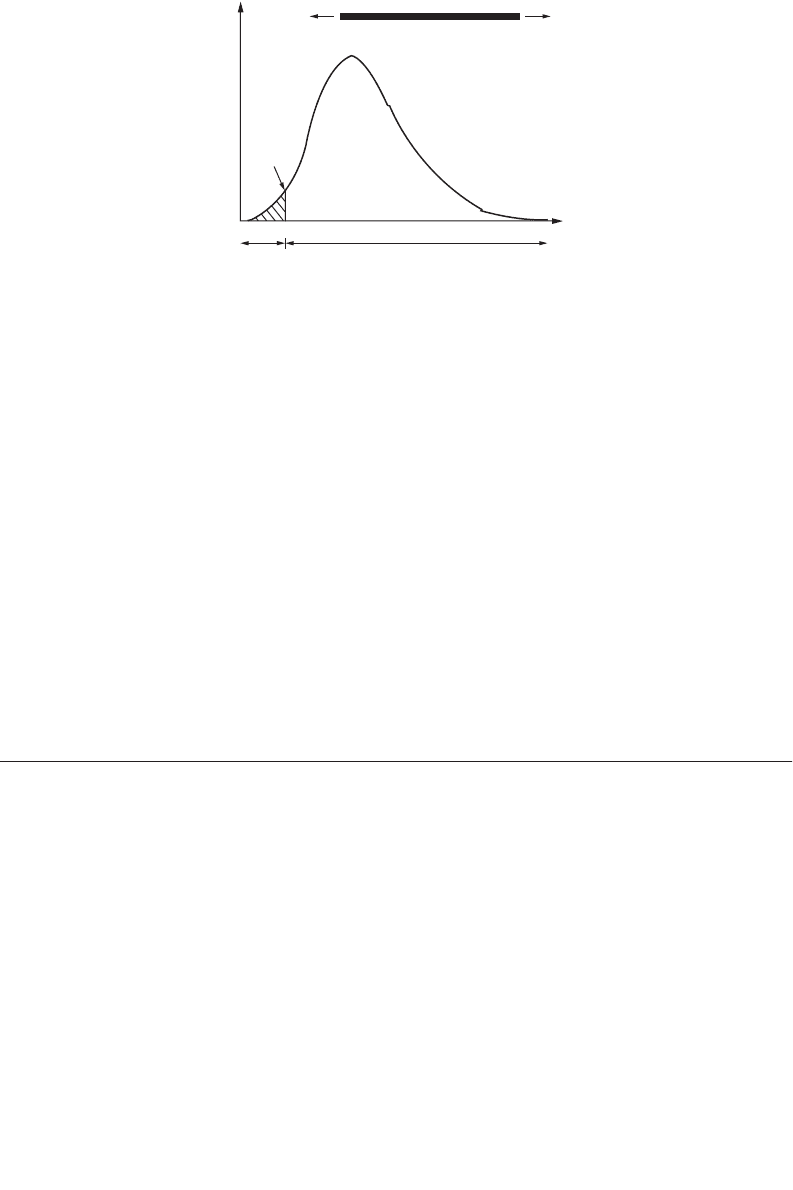
52
-2
The Civil Engineering Handbook, Second Edition
Performance against failure is ensured if
R
>
S
(i.e., supply exceeds demand). However, the capacity of
this particular bar cannot be known exactly unless it is tested to failure. Nevertheless, some estimates
can be obtained based on test results of similar bars, which can be summarized in the form of a
distribution. The proportion of bars with strength equal to or above
S
(assumed deterministic) gives an
indication of the reliability of this bar (see Fig. 52.1). Complementary to this, the proportion (shaded
region) of bars below
S
indicates the probability of failure of the system. Hence, reliability can be viewed
as a complementary to the
probability of failure
.
The simple example above can be extended to the case where
S
is not known with certainty. Similarly,
one can consider a more complicated function for
R
, e.g., a reinforced concrete beam where the capacity
is a function of many variables, such as the properties of the concrete and reinforcing bars used. One
can also look at the reliability of a structure comprising more than one bar or element. An exposition
to some basic probability concepts is prerequisite to understanding the complexity and solutions of such
problems.
52.2 Basic Probability Concepts
Random Variables and Probability Distributions
For the case of the tensile capacity of the bar mentioned above, its strength can be modeled as a
continuous
random variable
and denoted in general as
X
. Other engineering parameters may take on only discrete
values, such as the number of significant earthquakes, and hence modeled as a
discrete random variable
.
In either case, a histogram can be constructed once data are available and normalized such that the area
under it for the continuous random variable case (or the summation of the ordinates for the discrete
case) is unity.
A mathematical expression can be used to describe the distribution represented by the histogram,
which for the discrete case is known as the
probability mass function
(PMF), denoted as
p
X
(
x
), and for
the continuous case as
probability density function
(PDF), denoted as
f
X
(
x
).
The cumulative value of the mass or density from the smallest value of
X
can be described by its
cumulative distribution function
(CDF), commonly denoted as
F
X
(
x
) (see Fig. 52.2). Hence, one can write
the probability of
X
taking on values less than or equal to
a
as
(52.1a)
FIGURE 52.1
Distribution of
R
, failure, and safe regions.
Frequency
SS
Bar, tensile capacity
R
Distribution of
R
R
=
S
R
O
s
Failure
region
Safe or reliable region
PX aFafxdx for continuous X
XX
a
£
()
=
()
=
()
-•
Ú
© 2003 by CRC Press LLC
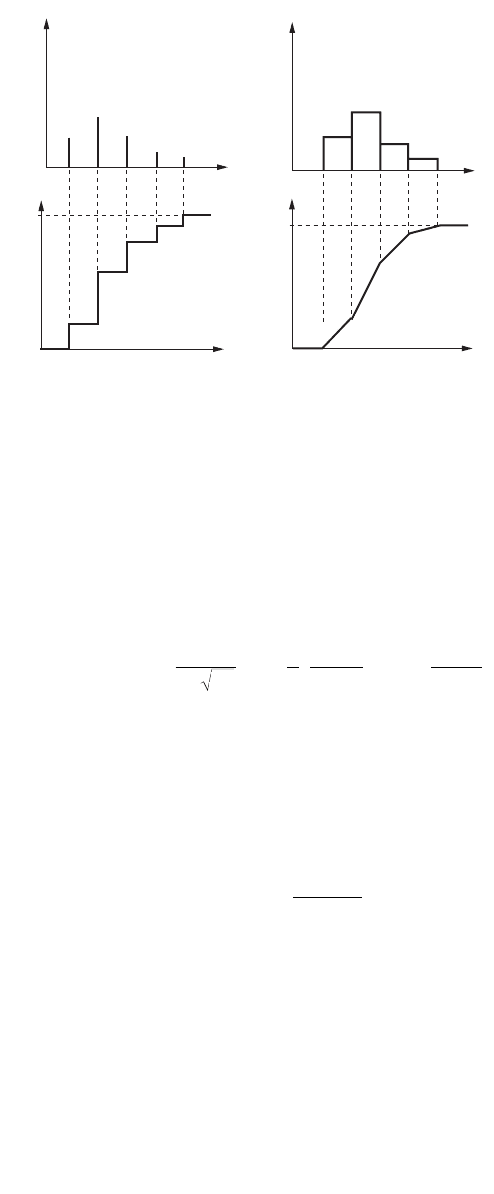
Structural Reliability
52
-3
(52.1b)
Commonly used probability functions related to engineering problems can be found in textbooks on
probability and statistics (e.g., Ang and Tang, 1975). Table 52.1 is provided for convenience.
The most common distribution used is the
normal distribution
, with two parameters, namely, mean,
m
X
, and standard deviation,
s
X
. It cumulative function
F
X
(
x
)
cannot be expressed in closed form and is
often denoted as
(52.2)
where
F
(.) denotes the CDF of a normal distribution with a mean equal to 0 and standard deviation
equal to 1. Its concise tabulated form is given in Table 52.2.
Another common distribution used, which spans over positive values of
X
, is the
lognormal distribution
,
with parameters
l
X
and
z
X
. Note that the transformation
Y = ln X
produces a normal distribution for
Y
.
The CDF of
X
can be conveniently evaluated as
(52.3)
Expectation and Moments
Consider a function
g
(
X
) where
X
is a random variable with PMF
p
X
(
x
)
or PDF
f
X
(
x
). The expected value
(also known as
expectation
) of
g
(
X
) is defined as
(52.4a)
(52.4b)
FIGURE 52.2
PMF (discrete random variable), PDF (continuous random variable), and corresponding CDFs.
0
X
X
X
0
0
1
X
1
0
CDF,
F
X
(
x
)
CDF,
F
X
(
x
)
PMF,
p
X
(
x
)
PDF,
f
X
(
x
)
Discrete random variable Continuous random variable
=
()
£
Â
px for discrete X
Xi
xa
i
PX a F a
xa
X
X
a
X
X
X
X
£
()
=
()
=-
-
Ê
Ë
Á
ˆ
¯
˜
È
Î
Í
Í
˘
˚
˙
˙
=
-
Ê
Ë
Á
ˆ
¯
˜
-•
Ú
1
2
1
2
2
sp
m
s
m
s
exp F
PX a F a
a
X
X
X
£
()
=
()
=
-
Ê
Ë
Á
ˆ
¯
˜
F
ln l
z
EgXgxf xdx for continuous X
X
()
[]
=
() ()
-•
•
Ú
=
() ()
Â
gx px for discrete X
iXi
all x
i
© 2003 by CRC Press LLC
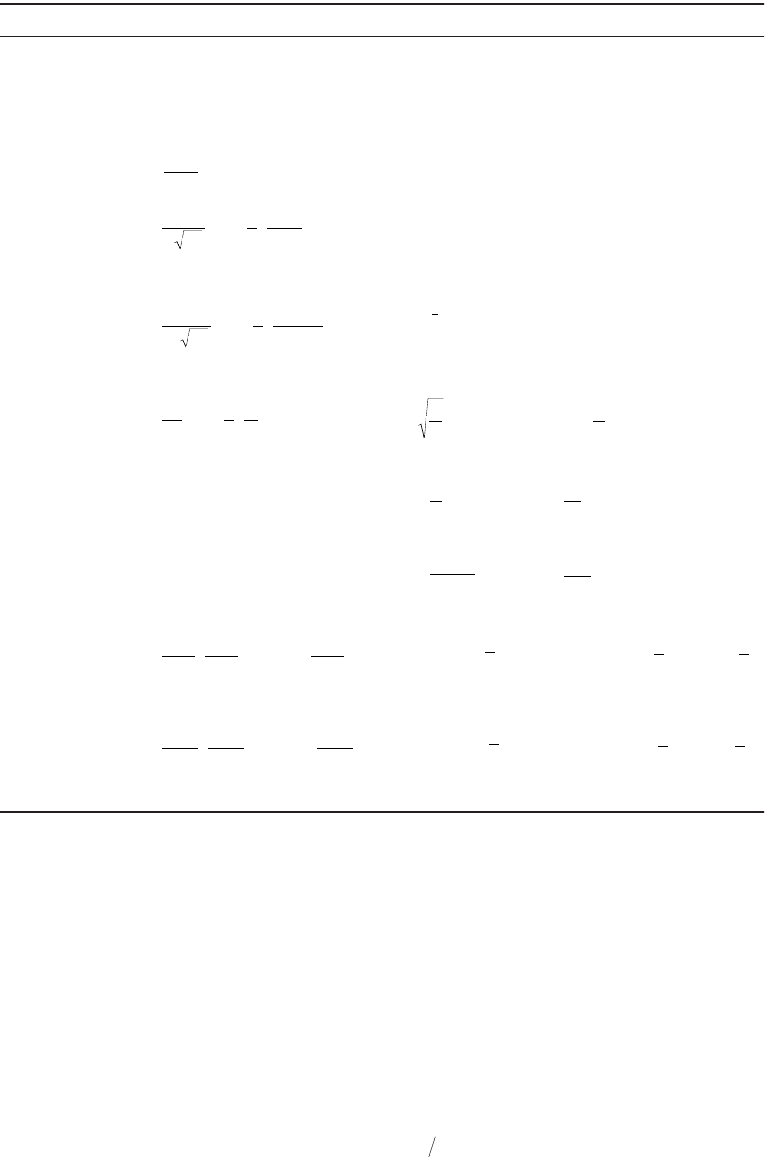
52
-4
The Civil Engineering Handbook, Second Edition
If
g
(
X
)
= X
, then Eq. (52.4) gives the
population mean
(denoted as
m
X
), which physically describes the
central tendency of the distribution of
X
. The mean is also known as the
first moment
of
X
.
In general, if
g
(
X
)
= X
n
, evaluation of Eq. (52.4) gives the
n
th moment of
X
, denoted as m
X
(n)
.
If g(X) = (X – m
X
)
2
, then Eq. (52.4) gives the population variance (denoted as s
X
2
), which measures
the spread of data around the mean value. It is also known as the second central moment and is related
to the second moment and the mean by
(52.5)
The square root of variance is the population standard deviation, and for m
X
π 0, its normalized form
is known as the coefficient of variation, that is,
(52.6)
TA BLE 52.1 Some Distribution Type
Distribution PMF (p
X
(x)) or PDF (f
X
(x)) Mean, E[X]Variance, Var[X]
Binomial np np(1 – p)
Poisson
n
t
n
t
Normal ms
2
Lognormal
Rayleigh
Exponential
Gumbel
type I
maximum
Fretchet
type II
maximum
We ib ull
type III
minimum
px
n
x
pp
xn
X
x
nx
()
=
Ê
Ë
Á
ˆ
¯
˜
-
()
=º
-
1
012,, , ,
px
vt
x
e
X
x
vt
()
=
()
-
!
fx
x
x
X
()
=-
-
Ê
Ë
Á
ˆ
¯
˜
È
Î
Í
Í
˘
˚
˙
˙
-•< <•
1
2
1
2
2
sp
m
s
exp
fx
x
x
x
X
()
=-
-
Ê
Ë
Á
ˆ
¯
˜
È
Î
Í
Í
˘
˚
˙
˙
<<•
1
2
1
2
0
2
zp
l
z
exp
ln
e
lz+
Ê
Ë
Á
ˆ
¯
˜
1
2
2
ee
2
2
2
1
lz
z
+
()
-
[]
fx
xx
x
X
()
=-
Ê
Ë
Á
ˆ
¯
˜
È
Î
Í
Í
˘
˚
˙
˙
£<•
a
a
2
2
1
2
0
exp
a
p
2
2
2
2
-
Ê
Ë
Á
ˆ
¯
˜
p
a
fx x
x
X
()
=--
()
[]
£<•
llt
t
exp
t
l
+
1
1
2
l
fx xu e
x
X
xu
()
=--
()
-
[]
-•< <•
--
()
aa
a
exp
u +
0 5772.
a
p
a
2
2
6
fx
k
v
v
x
v
x
x
X
kk
()
=
-
-
-
Ê
Ë
Á
ˆ
¯
˜
-
-
-
Ê
Ë
Á
ˆ
¯
˜
È
Î
Í
Í
˘
˚
˙
˙
<<•
+
t
t
t
t
t
e
1
exp
v
k
-
()
-
Ê
Ë
Á
ˆ
¯
˜
+ttG 1
1
v
kk
-
()
-
Ê
Ë
Á
ˆ
¯
˜
È
Î
Í
˘
˚
˙
--
Ê
Ë
Á
ˆ
¯
˜
t
2
2
1
2
1
1
GG
fx
k
w
x
w
x
w
x
X
kk
()
=
-
-
-
Ê
Ë
Á
ˆ
¯
˜
-
-
-
Ê
Ë
Á
ˆ
¯
˜
È
Î
Í
Í
˘
˚
˙
˙
<<•
-
e
e
e
e
e
e
1
exp
w
k
-
()
-
Ê
Ë
Á
ˆ
¯
˜
+eeG 1
1
w
kk
-
()
-
Ê
Ë
Á
ˆ
¯
˜
+-
Ê
Ë
Á
ˆ
¯
˜
È
Î
Í
˘
˚
˙
e
2
2
1
2
1
1
GG
sm m
XX X
EX EX
2
2
22
=-
()
[]
=
[]
-
COV V
XXX
==sm
© 2003 by CRC Press LLC
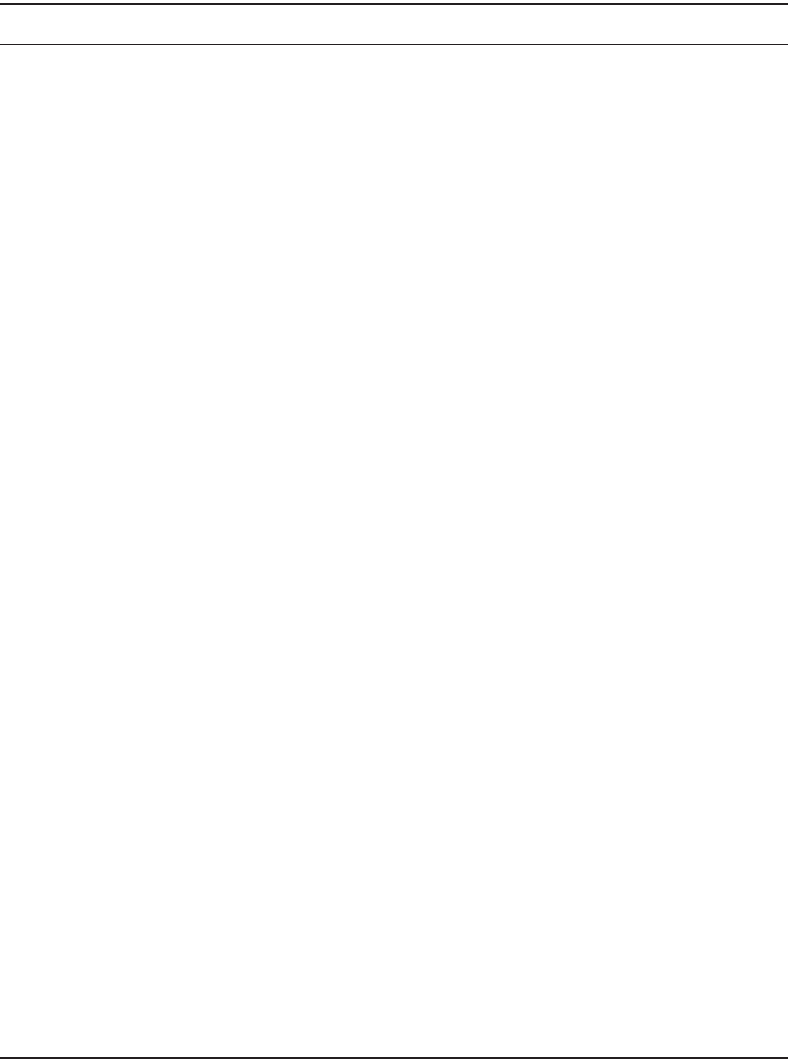
Structural Reliability 52-5
TA BLE 52.2 Values for F(Z)
Z .00 .01 .02 .03 .04 .05 .06 .07 .08 .09
–0.0 5.0000
E
-1 4.9601
E
-1 4.9202
E
-1 4.8803
E
-1 4.8405
E
-1 4.8006
E
-1 4.7608
E
-1 4.7210
E
-1 4.6812
E
-1 4.6414
E
-1
–0.1 4.6017
E
-1 4.5620
E
-1 4.5224
E
-1 4.4828
E
-1 4.4433
E
-1 4.4038
E
-1 4.3644
E
-1 4.3251
E
-1 4.2858
E
-1 4.2465
E
-1
–0.2 4.2074
E
-1 4.1683
E
-1 4.1294
E
-1 4.0905
E
-1 4.0517
E
-1 4.0129
E
-1 3.9743
E
-1 3.9358
E
-1 3.8974
E
-1 3.8591
E
-1
–0.3 3.8209
E
-1 3.7828
E
-1 3.7448
E
-1 3.7070
E
-1 3.6993
E
-1 3.6317
E
-1 3.5942
E
-1 3.5569
E
-1 3.5197
E
-1 3.4827
E
-1
–0.4 3.4458
E
-1 3.4090
E
-1 3.3724
E
-1 3.3360
E
-1 3.2997
E
-1 3.2636
E
-1 3.2276
E
-1 3.1918
E
-1 3.1561
E
-1 3.1207
E
-1
–0.5 3.0854
E
-1 3.0503
E
-1 3.0153
E
-1 2.9806
E
-1 2.9460
E
-1 2.9116
E
-1 2.8774
E
-1 2.8434
E
-1 2.8096
E
-1 2.7760
E
-1
–0.6 2.7425
E
-1 2.7093
E
-1 2.6763
E
-1 2.6435
E
-1 2.6109
E
-1 2.5785
E
-1 2.5463
E
-1 2.5143
E
-1 2.4825
E
-1 2.4510
E
-1
–0.7 2.4196
E
-1 2.3885
E
-1 2.3576
E
-1 2.3270
E
-1 2.2965
E
-1 2.2663
E
-1 2.2363
E
-1 2.2065
E
-1 2.1770
E
-1 2.1476
E
-1
–0.8 2.1186
E
-1 2.0897
E
-1 2.0611
E
-1 2.0327
E
-1 2.0045
E
-1 1.9766
E
-1 1.9489
E
-1 1.9215
E
-1 1.8943
E
-1 1.8673
E
-1
–0.9 1.8406
E
-1 1.8141
E
-1 1.7879
E
-1 1.7619
E
-1 1.7361
E
-1 1.7106
E
-1 1.6853
E
-1 1.6602
E
-1 1.6354
E
-1 1.6109
E
-1
–1.0 1.5866
E
-1 1.5625
E
-1 1.5386
E
-1 1.5151
E
-1 1.4917
E
-1 1.4686
E
-1 1.4457
E
-1 1.4231
E
-1 1.4007
E
-1 1.3786
E
-1
–1.1 1.3567
E
-1 1.3350
E
-1 1.3136
E
-1 1.2924
E
-1 1.2714
E
-1 1.2507
E
-1 1.2302
E
-1 1.2100
E
-1 1.1900
E
-1 1.1702
E
-1
–1.2 1.1507
E
-1 1.1314
E
-1 1.1123
E
-1 1.0935
E
-1 1.0749
E
-1 1.0565
E
-1 1.0383
E
-1 1.0204
E
-1 1.0027
E
-1 9.8525
E
-2
–1.3 9.6800
E
-2 9.5098
E
-2 9.3418
E
-2 9.1759
E
-2 9.0123
E
-2 8.8508
E
-2 8.6915
E
-2 8.5343
E
-2 8.3793
E
-2 8.2264
E
-2
–1.4 8.0757
E
-2 7.9270
E
-2 7.7804
E
-2 7.6359
E
-2 7.4934
E
-2 7.3529
E
-2 7.2145
E
-2 7.0781
E
-2 6.9437
E
-2 6.8112
E
-2
–1.5 6.6807
E
-2 6.5522
E
-2 6.4255
E
-2 6.3008
E
-2 6.1780
E
-2 6.0571
E
-2 5.9380
E
-2 5.8208
E
-2 5.7053
E
-2 5.5917
E
-2
–1.6 5.4799
E
-2 5.3699
E
-2 5.2616
E
-2 5.1551
E
-2 5.0503
E
-2 4.9471
E
-2 4.8457
E
-2 4.7460
E
-2 4.6479
E
-2 4.5514
E
-2
–1.7 4.4565
E
-2 4.3633
E
-2 4.2716
E
-2 4.1815
E
-2 4.0930
E
-2 4.0059
E
-2 3.9204
E
-2 3.8364
E
-2 3.7538
E
-2 3.6727
E
-2
–1.8 3.5930
E
-2 3.5148
E
-2 3.4380
E
-2 3.3625
E
-2 3.2884
E
-2 3.2157
E
-2 3.1443
E
-2 3.0742
E
-2 3.0054
E
-2 2.9379
E
-2
–1.9 2.8717
E
-2 2.8067
E
-2 2.7429
E
-2 2.6803
E
-2 2.6190
E
-2 2.5588
E
-2 2.4998
E
-2 2.4419
E
-2 2.3852
E
-2 2.3295
E
-2
–2.0 2.2750
E
-2 2.2216
E
-2 2.1692
E
-2 2.1178
E
-2 2.0675
E
-2 2.0182
E
-2 1.9699
E
-2 1.9226
E
-2 1.8763
E
-2 1.8309
E
-2
–2.1 1.7864
E
-2 1.7429
E
-2 1.7003
E
-2 1.6586
E
-2 1.6177
E
-2 1.5778
E
-2 1.5386
E
-2 1.5003
E
-2 1.4629
E
-2 1.4262
E
-2
–2.2 1.3903
E
-2 1.3553
E
-2 1.3209
E
-2 1.2874
E
-2 1.2545
E
-2 1.2224
E
-2 1.1911
E
-2 1.1604
E
-2 1.1304
E
-2 1.1011
E
-2
–2.3 1.0724
E
-2 1.0444
E
-2 1.0170
E
-2 9.9031
E
-3 9.6419
E
-3 9.3867
E
-3 9.1375
E
-3 8.8940
E
-3 8.6563
E
-3 8.4242
E
-3
–2.4 8.1975
E
-3 7.9763
E
-3 7.7603
E
-3 7.5494
E
-3 7.3436
E
-3 7.1428
E
-3 6.9469
E
-3 6.7557
E
-3 6.5691
E
-3 6.3872
E
-3
–2.5 6.2097
E
-3 6.0366
E
-3 5.8677
E
-3 5.7031
E
-3 5.5426
E
-3 5.3861
E
-3 5.2336
E
-3 5.0849
E
-3 4.9400
E
-3 4.7988
E
-3
–2.6 4.6612
E
-3 4.5271
E
-3 4.3965
E
-3 4.2692
E
-3 4.1453
E
-3 4.0246
E
-3 3.9070
E
-3 3.7926
E
-3 3.6811
E
-3 3.5726
E
-3
–2.7 3.4670
E
-3 3.3642
E
-3 3.2641
E
-3 3.1667
E
-3 3.0720
E
-3 2.9798
E
-3 2.8901
E
-3 2.8028
E
-3 2.7179
E
-3 2.6354
E
-3
–2.8 2.5551
E
-3 2.4771
E
-3 2.4012
E
-3 2.3274
E
-3 2.2557
E
-3 2.1860
E
-3 2.1182
E
-3 2.0524
E
-3 1.9884
E
-3 1.9262
E
-3
–2.9 1.8658
E
-3 1.8071
E
-3 1.7502
E
-3 1.6948
E
-3 1.6411
E
-3 1.5889
E
-3 1.5382
E
-3 1.4890
E
-3 1.4412
E
-3 1.3949
E
-3
–3.0 1.3499
E
-3 1.3062
E
-3 1.2639
E
-3 1.2228
E
-3 1.1829
E
-3 1.1442
E
-3 1.1067
E
-3 1.0703
E
-3 1.0350
E
-3 1.0008
E
-3
–3.1 9.6760
E
-4 9.3544
E
-4 9.0426
E
-4 8.7403
E
-4 8.4474
E
-4 8.1635
E
-4 7.8885
E
-4 7.6219
E
-4 7.3638
E
-4 7.1136
E
-4
–3.2 6.8714
E
-4 6.6367
E
-4 6.4095
E
-4 6.1895
E
-4 5.9765
E
-4 5.7703
E
-4 5.5706
E
-4 5.3774
E
-4 5.1904
E
-4 5.0094
E
-4
–3.3 4.8342
E
-4 4.6648
E
-4 4.5009
E
-4 4.3423
E
-4 4.1889
E
-4 4.0406
E
-4 3.8971
E
-4 3.7584
E
-4 3.6243
E
-4 3.4946
E
-4
–3.4 3.3693
E
-4 3.2481
E
-4 3.1311
E
-4 3.0179
E
-4 2.9086
E
-4 2.8029
E
-4 2.7009
E
-4 2.6023
E
-4 2.5071
E
-4 2.4151
E
-4
–3.5 2.3263
E
-4 2.2405
E
-4 2.1577
E
-4 2.0778
E
-4 2.0006
E
-4 1.9262
E
-4 1.8543
E
-4 1.7849
E
-4 1.7180
E
-4 1.6534
E
-4
–3.6 1.5911
E
-4 1.5310
E
-4 1.4730
E
-4 1.4171
E
-4 1.3632
E
-4 1.3112
E
-4 1.2611
E
-4 1.2128
E
-4 1.1662
E
-4 1.1213
E
-4
–3.7 1.0780
E
-4 1.0363
E
-4 9.9611
E
-5 9.5740
E
-5 9.2010
E
-5 8.8417
E
-5 8.4957
E
-5 8.1624
E
-5 7.8414
E
-5 7.5324
E
-5
–3.8 7.2348
E
-5 6.9483
E
-5 6.6726
E
-5 6.4072
E
-5 6.1517
E
-5 5.9059
E
-5 5.6694
E
-5 5.4418
E
-5 5.2228
E
-5 5.0122
E
-5
–3.9 4.8096
E
-5 4.6148
E
-5 4.4274
E
-5 4.2473
E
-5 4.0741
E
-5 3.9076
E
-5 3.7475
E
-5 3.5936
E
-5 3.4458
E
-5 3.3037
E
-5
–4.0 3.1671
E
-5 3.0359
E
-5 2.9099
E
-5 2.7888
E
-5 2.6726
E
-5 2.5609
E
-5 2.4536
E
-5 2.3507
E
-5 2.2518
E
-5 2.1569
E
-5
–4.1 2.0658
E
-5 1.9783
E
-5 1.8944
E
-5 1.8138
E
-5 1.7365
E
-5 1.6624
E
-5 1.5912
E
-5 1.5230
E
-5 1.4575
E
-5 1.3948
E
-5
–4.2 1.3346
E
-5 1.2769
E
-5 1.2215
E
-5 1.1685
E
-5 1.1176
E
-5 1.0689
E
-5 1.0221
E
-5 9.7736
E
-6 9.3447
E
-6 8.9337
E
-6
–4.3 8.5399
E
-6 8.1627
E
-6 7.8015
E
-6 7.4555
E
-6 7.1241
E
-6 6.8069
E
-6 6.5031
E
-6 6.2123
E
-6 5.9340
E
-6 5.6675
E
-6
–4.4 5.4125
E
-6 5.1685
E
-6 4.9350
E
-6 4.7117
E
-6 4.4979
E
-6 4.2935
E
-6 4.0980
E
-6 3.9110
E
-6 3.7322
E
-6 3.5612
E
-6
–4.5 3.3977
E
-6 3.2414
E
-6 3.0920
E
-6 2.9492
E
-6 2.8127
E
-6 2.6823
E
-6 2.5577
E
-6 2.4386
E
-6 2.3249
E
-6 2.2162
E
-6
–4.6 2.1125
E
-6 2.0133
E
-6 1.9187
E
-6 1.8283
E
-6 1.7420
E
-6 1.6597
E
-6 1.5810
E
-6 1.5060
E
-6 1.4344
E
-6 1.3660
E
-6
–4.7 1.3008
E
-6 1.2386
E
-6 1.1792
E
-6 1.1226
E
-6 1.0686
E
-6 1.0171
E
-6 9.6796
E
-7 9.2113
E
-7 8.7648
E
-7 8.3391
E
-7
–4.8 7.9333
E
-7 7.5465
E
-7 7.1779
E
-7 6.8267
E
-7 6.4920
E
-7 6.1731
E
-7 5.8693
E
-7 5.5799
E
-7 5.3043
E
-7 5.0418
E
-7
–4.9 4.7918
E
-7 4.5538
E
-7 4.3272
E
-7 4.1115
E
-7 3.9061
E
-7 3.7107
E
-7 3.5247
E
-7 3.3476
E
-7 3.1792
E
-7 3.0190
E
-7
Note: F(–Z) = 1 – F(Z), e.g., F(2) = 1– F(–2).
© 2003 by CRC Press LLC
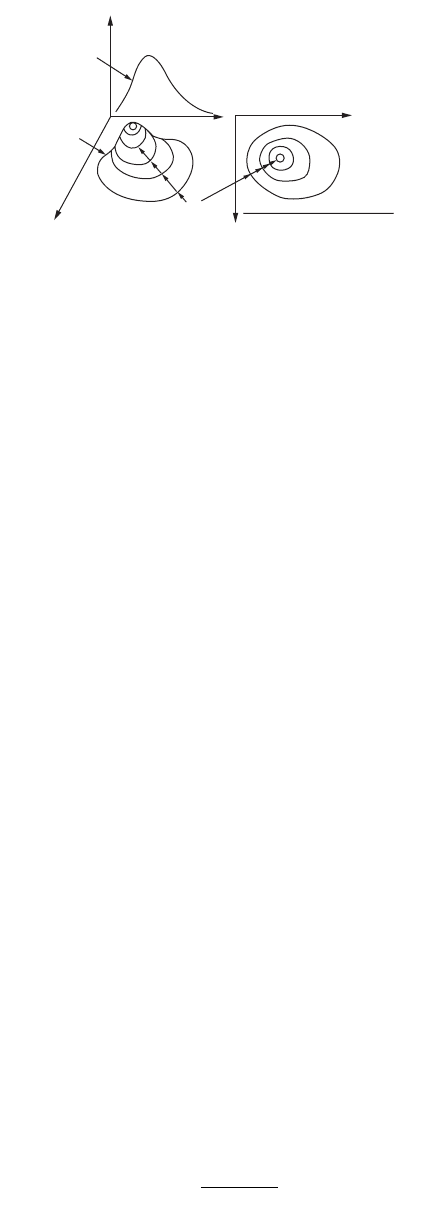
52-6 The Civil Engineering Handbook, Second Edition
Higher order central moments can be defined, where g(X) = (X – m
X
)
n
. For example, n = 3 gives the
third central moment and is a measure of the skewness of the distribution, and n = 4 gives the fourth
central moment and is a measure of the peakedness (or flatness) of the distribution. The third and fourth
central moments for a normal distribution are 0 and 3s
x
2
,respectively.
Joint Distribution and Correlation Coefficient
Invariably, all engineering problems involve more than one variable that are random and may be
related to one another. To estimate the distribution of multiple random variables, data are jointly
collected, from which a multidimensional histogram can be plotted. A suitable joint probability mass
function or density function may be used to represent the spread of data. An example of a joint PDF
f
XY
(x, y) for two random variables, X and Y, is illustrated in Fig. 52.3. The plan view is a two-dimensional
contour representation of the three-dimensional plot. Lower probability information can be deduced
from the joint probability function; for example, the marginal PDF of Y is given by
(52.7)
as illustrated in Fig. 52.3.
Consider the random variable Z, which is the sum of two random variables X and Y, that is, Z = X +
Y. The mean and variance of Z can be expressed as
(52.8)
(52.9)
where Cov[X, Y] = E[(X – m
X
)(Y – m
Y
)] is the covariance between X and Y. It is a measure of their linear
interdependence, and its normalized form is known as the correlation coefficient, given by
(52.10)
FIGURE 52.3 Joint probability density function.
Contours
of equal
probability
density
X
PLAN VIEW ON X-Y PLANE
Y
Y
f
XY
(x,y)
Marginal
probability
density
function f
Y
(y)
Joint
probability
density
function
f
XY
(x,y)
X
fy f xydx
YXY
()
=
()
-•
•
Ú
,
mmm
ZXY
EZ EX Y EX EY=
[]
=+
[]
=
[]
+
[]
=+
smmm
mm mm
ss ss rss
ZZXY
XY XY
XY XY XYXY
Var Z E Z E X Y
EX EY EX Y
Cov X Y
2
2
2
22
22 22
2
22
=
[]
=-
()
[]
=-
()
+-
()
{}
È
Î
Í
˘
˚
˙
=-
()
[]
+-
()
[]
+-
()
-
()
[]
=++
[]
=++,
r
ss
XY
XY
Cov X Y
=
[]
,
© 2003 by CRC Press LLC
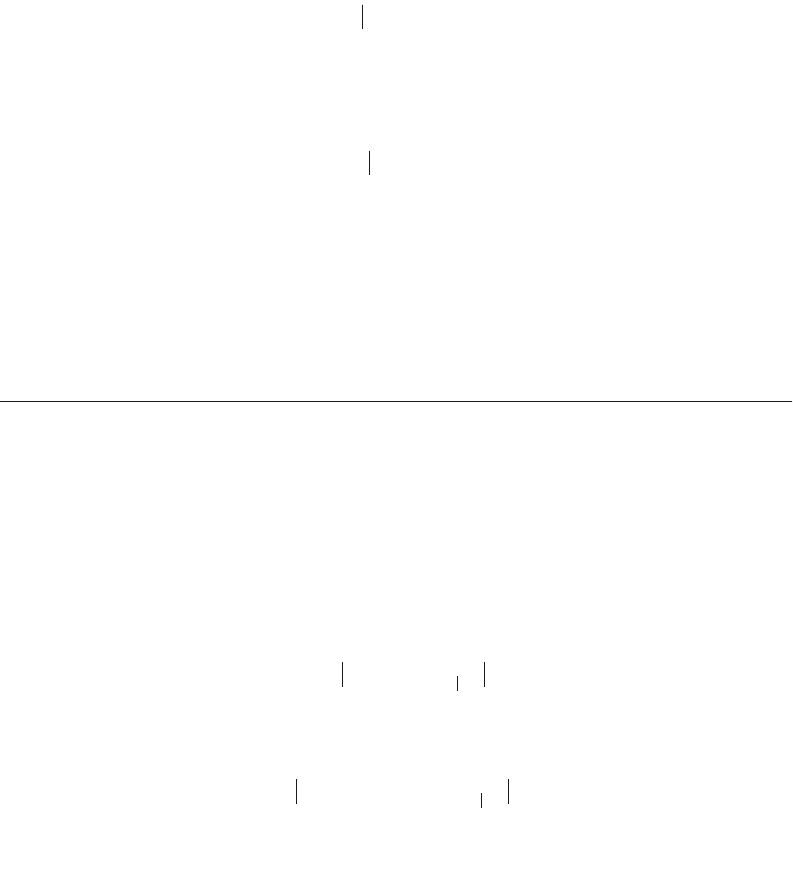
Structural Reliability 52-7
When r
XY
= +1, X and Y are said to be perfectly positive correlated, whereas r
XY
= –1 implies perfect
negative correlation (“negative” meaning that high values of X occur with low values of Y and vice versa).
When r
XY
= 0, X and Y are said to be uncorrelated.
It is appropriate to mention here that for the special case where X and Y are normally distributed,
their sum (and also difference), Z, follows a normal distribution.
Statistical Independence
Practical problems involve more than one random variable with varying degrees of interdependence
among them. An extreme case is when the random variables, say X and Y, are statistically independent,
meaning that the event of one variable taking on some value does not affect the probability of the other
variable taking on another value. That is,
(52.11)
where the symbol | denotes “given that,” and the left-hand side of Eq. (52.11) is a conditional probability.
As a consequence of Eq. (52.11), the probability of the two events, X £ a and Y £ b, happening together
(denoted by the intersection symbol «) can be simplified as
(52.12)
Note that if two variables are statistically independent, they must also be uncorrelated, but the converse
is not true in general.
The concept of statistical independence permits simplification in solving complex reliability problems
approximately. In fact, a number of real quantities can be reasonably assumed as statistically independent.
For example, one would expect dead load to be relatively independent of wind load, the occurrence of tornado
to be independent of the occurrence of earthquake, and loads to be independent of structural capacity.
52.3 Assessment of Reliability
A brief exposure is provided here for engineers who wish to have some basic understanding of structural
reliability theory. Those interested in a more complete treatment should refer to the many textbooks in
this field, such as Ang and Tang (1984), Ditlevsen and Madsen (1996), Madsen et al. (1986), Melchers
(1999), and Nowak and Collins (2000).
Fundamental Case
Consider the bar in tension shown in Fig. 52.1 and denote the PDF of R as f
R
(r) and the deterministic
load as S = s
1
. Then the probability of failure is given by
(52.13)
For the case where S is also random, described by the PDF f
s
(s), Eq. (52.13) becomes
(52.14)
which is the volume of the joint PDF in the failure region defined by R £ S.
PX aY b PX a££
()
=£
()
PX a Y b PX aY bPY b PX a PY b£« £
()
=££
()
£
()
=£
()
£
()
pPRSSs frSsdr
f
RS
s
=£=
()
==
()
-•
Ú
11
1
pPRSSsfsds frSsfsdrds
frsdrds
fS
RS
S
s
RS
s
=£=
()
()
==
()
()
=
()
-•
•
-•-•
•
-•-•
•
ÚÚÚ
ÚÚ
,
© 2003 by CRC Press LLC
